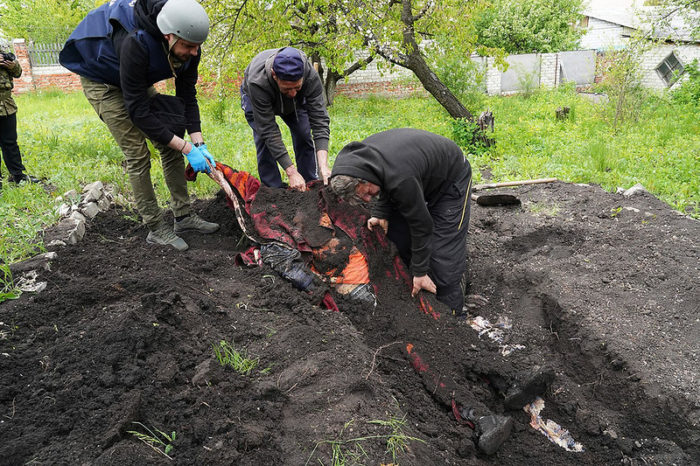We have already seen this pattern of Russian war crimes in Bucha, and the Putin regime's premeditated program of genocide against Ukraine is to blame.
After the crimes near Kyiv in March of this year, when the Russian army shot at unarmed residents, the Kremlin continues to "open the portal" into the dark barbaric past of humanity, when ruthless violence, torture, and intimidation were common practice.
The rapid de-occupation of the Kharkiv Oblast of Ukraine allowed the police to record Russian war crimes committed in almost every village. Their analysis shows how the aggressor country acts on occupied lands after the promotional pseudo-referendum, which it uses to cover the seizure of new lands.
Network of 18 Russian torture chambers found in liberated Kharkiv Oblast, Ukraine
From 6 to 14 September, about 8,500 square kilometers were liberated in the Kharkiv Oblast, 388 settlements with a population of 150,000. The police said that a network of 18 Russian torture chambers was discovered in the liberated towns of Ukraine.
Testimonies collected by the investigators show that during the "interrogations" of detainees, Russians, particularly from Russia's Security Service (FSB), often use electric shocks. Representatives of Russian proxy formations from the so-called "DNR" and "LNR" ("Donetsk and Luhansk People's Republics") participate in the illegal detaining of people. This again reminds us that the territory occupied by Russia immediately becomes a training ground for new criminals.
There have been frequent cases of murder, robbery, abduction, rape, and intimidation of citizens.
Under occupation, all those who show their loyalty to Ukraine become the target of terror.
In addition to civic activists, Russia's special services also hunt down former military and law enforcement officials who were not combatants. As well as relatives of people of these categories.
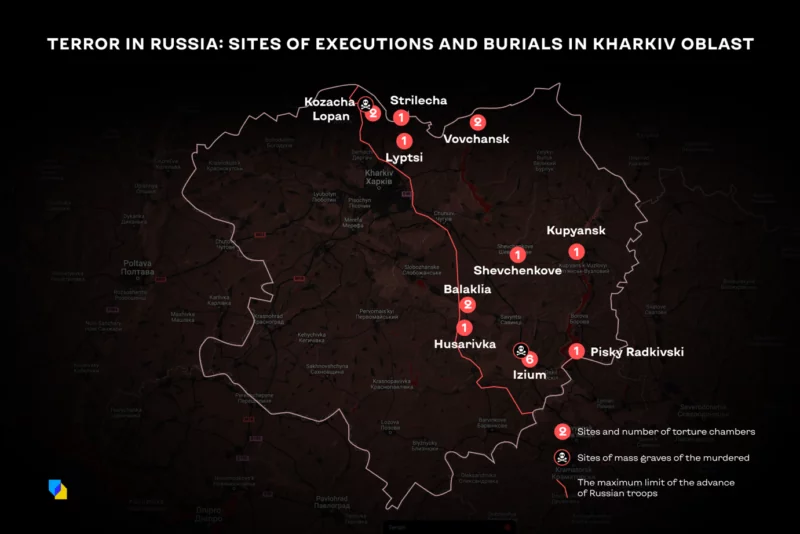
Terror in Russia: sites of executions and burials in Kharkiv Oblast
On the eve of the full-scale invasion, the Foreign Policy publication, citing data from American intelligence agencies, reported the existence of a formalized list in Russia, which included, among other things, Ukrainian journalists and activists whom the Kremlin wanted to capture or execute after seizing Ukraine.
Consequently, acts of terror were an integral part of the occupation program even before Russian missiles targeted Ukrainian cities.
This is similar to the continuation of the Cheka/NKVD strategy during the war for Ukrainian lands a hundred years ago. At that time, the Bolsheviks formally declared "red terror" in the country. They took representatives of the enemy strata among the population as hostages in the territory occupied by the Red Army.
In the Kharkiv Oblast, kidnapping and bullying were also widely used against school teachers who refused to work for Russia.
Indiscriminate shelling of residential areas in Kharkiv Oblast
Since many people disappeared without a trace, it is now difficult to establish accurately how many of them were killed and how many were taken to Russia. Currently, most of the bodies found in Kharkiv Oblast are victims of the indiscriminate use of missiles, shells, and bombs by the Russian army on residential premises.
A 57-year-old resident of Izium told The Guardian about such shelling. He also reported that Russian soldiers
"prepared a list of persons to be 'hunted down,' people who may have weapons, rich or 'dangerous,' including businessmen, activists, military and their families."
MP of the Izium City Council Maksym Strelnyk estimated that at least 1,000 civilians died as a result of military actions in Izium alone.
For example, an air bomb that hit a multi-story building in Izium on 9 March, when the Russians tried to seize the city, killed about 50 people under the ruins. Therefore, in the improvised cemetery in Izium, which was formed during the occupation of the city by the Russian army, there are, for example, the burial of the Stolpakov family: 31-year-old Olena, her husband, her daughter, as well as her parents, among 445 graves with crosses.
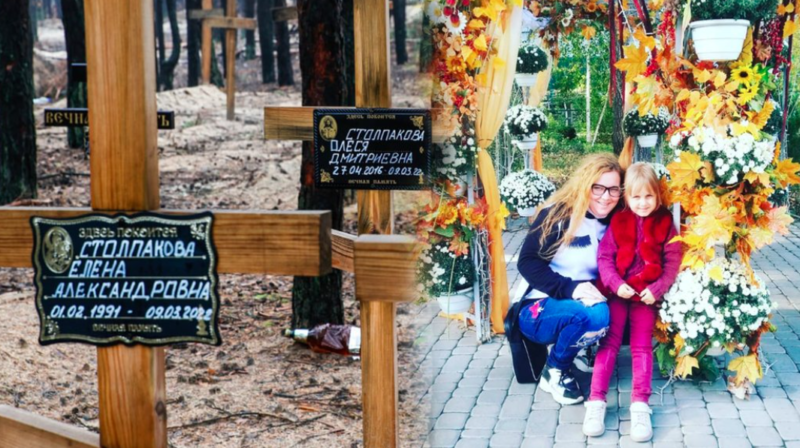
Olena Stolpakova with her younger daughter and the place of their burial in Izium Photo: Radio Liberty / Suspilne
The indiscriminate use of weapons is also evidenced by the fact that on 22 September, prosecutors, together with police officers, while inspecting Kupiansk, a city recently liberated by the Ukrainian Army in Kharkiv Oblast, discovered FAB-500 parachuted concrete-piercing air bombs, which did not explode. The length of each bomb is more than 2 m, and the weight of the warhead reaches half a ton.
In general, the Kharkiv Oblast Prosecutor's Office reported on September 28 that Russian occupiers killed 56 children in Kharkiv Oblast since the beginning of the war.
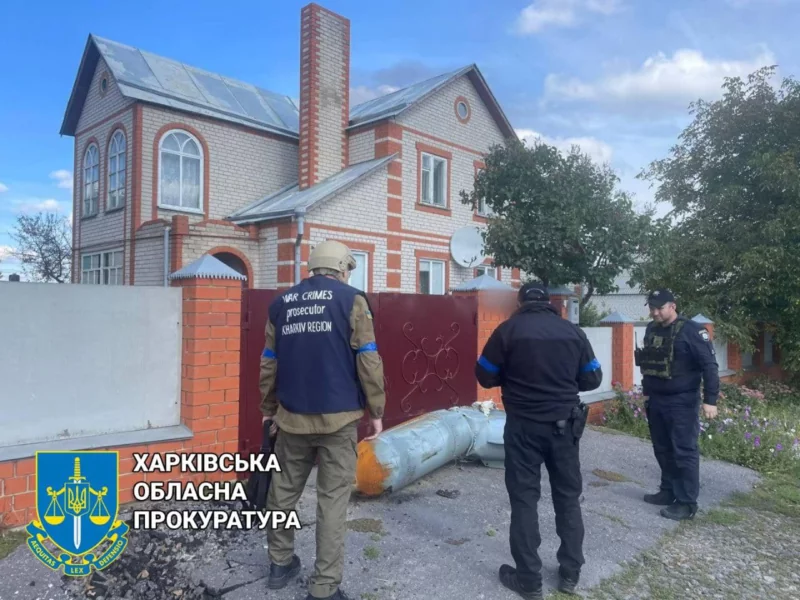
FAB-500, which fell in the purely residential areas of Kupiansk
Kidnapping, arbitrary detention, torture, rape, execution: Russian war crimes in Kharkiv Oblast
However, many victims of mass burials were not killed in shelling and bombing but were executed during the occupation. Exhumed bodies showed signs of torture, such as a rope around the neck.
“Thin fingers raised like a final plea for help.” Exhuming the Izium massacre
to the First Deputy Chief of the Main Investigation Department of the National Police of Ukraine Serhii Panteleiev, as of September 23, 18 places where citizens were detained and tortured were discovered after the de-occupation of the Kharkiv Oblast. More than 1,500 inspections of war crimes were conducted in the region.
In total, since the beginning of the full-scale invasion, the police have initiated 34,000 criminal proceedings for the commission of war crimes by the armed forces of Russia, including its private military companies and proxy formations, the so-called "DNR" and "LNR."
School teachers who refuse to work for the occupier become targets of Russian terror. They are intimidated, kidnapped, and abused. For example, primary school teacher Olha Istotska from the village of Lyptsi in Kharkiv Oblast told how people with machine guns came to her, said that they hated and were ready to kill "Ukrainians, Poles, and Belarusians" and forced her to leave.
Lidiia Tilna, a 62-year-old school principal from the village of Ivanivka in the Kharkiv Oblast, said that she was kidnapped, starved, threatened with death, and kept in the basement for refusing to work for Russia. Viktoriia Shcherbak, a teacher from Balakliia, a town in occupied Ukraine, said that she and her family were imprisoned in a Russian torture chamber, where she was forced to cooperate with threats to rape a 16-year-old daughter in front of her.
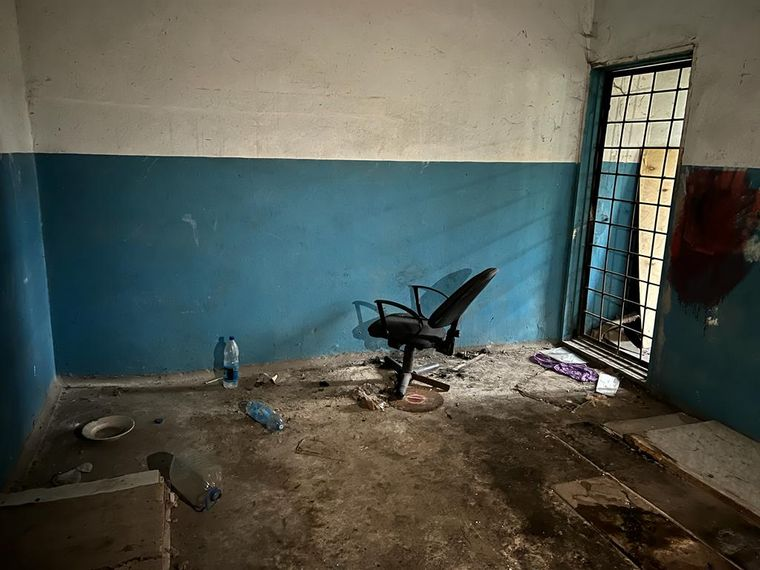
Russian torture chamber in Vovchansk, Kharkiv Oblast (Ukraine). Photo: National Police
In total, 200 people could have gone through the Russian torture chamber in Izium, northeastern Ukraine, discovered in the police station.
"Logs with a list of detainees kept by the Rashists are already discovered, as well as instruments of torture — electric cables,"
said the Head of the Investigative Department of the National Police in Kharkiv Oblast, Serhii Bolvinov.
"Moreover, every cell where people were held is investigated — DNA samples and fingerprints are extracted, and a database of evidence is collected for the court. People stayed in the dark basement cells for several weeks to months, not even always understanding what the occupiers wanted them to do."
The employee of the State Emergency Service Albina Strilets told what happened in the Russian torture chamber in Izium. The occupiers kidnapped her from the unit of the State Emergency Service, along with another colleague, putting a bag over her head and handcuffs right at work. The kidnappers threatened:
"Count yourself lost to everyone. You will not get out."
The woman was captured for her pro-Ukrainian position and forced to "take the side" of Russia, continuously threatened with being killed. The woman was held in prison from 3 to 19 August and then taken from the occupied territory to a Ukrainian checkpoint.
According to Albina Strilets, she heard the Russian military organizing mass rapes, beatings, and using electric shocks in the torture chamber.
The resident of Izium told that her son, who was walking with his wife to the market, was beaten by the occupiers right on the street, and her daughter-in-law was raped for a long time, and then forced to bring her rapists to her home. The other son was also taken right out of the house and beaten.
According to eyewitness accounts, Russian soldiers are often drunk or under the influence of other stimulants.
In the village of Mala Rohan in Kharkiv Oblast, according to fellow villagers, civilians were shot dead. In particular, Valerii Kot came out of the cellar to see if the windows were intact. Another person was killed right in the flat for not opening the door.
According to the village residents, the occupiers broke into the house where a family lived
, and shooting with a machine gun, "took the girl" to the second floor.
In the de-occupied Lyptsi in northeastern Ukraine, they found a Russian torture chamber housing the so-called "LNR people's militia." According to the Security Service of Ukraine, the Russians used cruel torture against prisoners, followed by forcible deportation to Russian territory. Deputy head of Derhachi Prosecutor's Office Anton Yevtushenko reported that before the full-scale invasion, about 4,000 people lived in this village. After the occupation, about half of the residents were deported to Russia.
"It is currently impossible to identify all the people affected by the Russian occupation forces, as the Russian troops took part part of the population to Russia. I believe that 80% of citizens were taken away by force or under pressure from the Russian military," Yevtushenko says.
Volunteer Tata Kepler testified that Russians use information terror against the local population, convincing people that Ukraine now considers them traitors:
"The rhetoric was the same as in Mariupol: Kyiv has fallen, you are traitors to Ukraine, if the Armed Forces of Ukraine come here, you will all be killed."
After the village of Zaliznychne, Chkalovska amalgamated community of Chuhuiv district was de-occupied, four village residents were found killed.
Serhii Bolvinov shared some details:
"The war crimes of Russia's army include shooting civilians in the head and the back. In Zaliznychne (next to Chuhuiv), there have already been four statements from locals about shootings they witnessed. Serhii, 61. Shot in the back of his home. His neighbors buried the body in the garden. Ilham, 58, and Kostiantyn. Buried in Ilham's yard, bullet wounds to the head were found during the examination. Volodymyr, 47. The body had been lying on the factory tower opposite the station since 26 February. According to the locals, he was shot with a machine gun."
CNN also covered the murders of Ilham and Kostiantyn in their coverage of Zaliznychne. Journalists quoted a witness, Mariia Hryhorova, who had to bury her neighbor and his friend killed by Russians in February 2022.
"I noticed the doors stayed open for a few days. When I went to check if they were alive or wounded, they were already cold, and then I saw two holes on Kostiantyn's forehead."
According to Kharkiv Oblast Prosecutor's Office, all four bodies in Zaliznychne had traces of torture.
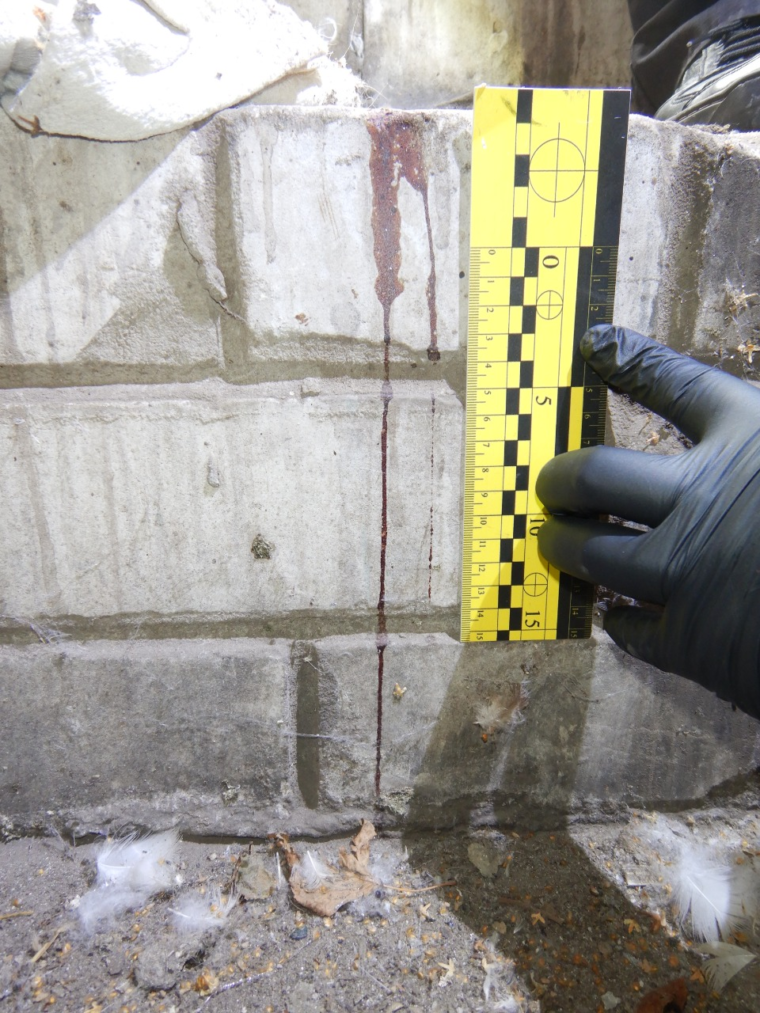
At the site of the murder of a 58-year-old resident of village Cherkaski Tyshky by the occupiers. Photo: press service of the State Police Chief Directorate in the Kharkiv Oblast.
In Hrakove village, the police found two young men shot in the back of the head. DW journalists covered this case in their report. They talked to Serhii Lutsai, a local resident who showed the burial place to the National Police.
Serhii Bolvinov shared some details of the crime:
"At the beginning of the occupation, back in March, ruscists [Russians] killed two people and forced the locals to dig graves and bury them. On-site, a witness, a resident of this same village who buried the killed, explained that the ruscists tortured the men before being killed, and their ears were cut off. The bodies were exhumed, examined, and sent for a forensic medical examination. The examination observed bullet wounds in the back of the head and no ears."
Two more burial places of residents were discovered in the village.
A resident of Velyki Prokhody, Liubov Kashaieva, told BBC News Ukraine how Russian soldiers beat up her husband just for saying he did not have a phone. According to the man, he was later detained for two weeks, akin to torture, because there was no place to lie down in the cell with a wet floor. The prisoners were fed with waste food once a week.
According to Oleksandr Kulyk
, speaker of the head of the Derhachi Community, a Russian torture chamber was also set up in the basement of the train station in Kozacha Lopan, also in northeastern Ukraine.
There were dozens of people who were severely beaten and given electric shocks. Some of them are still in hospitals. They were mostly former Ukrainian soldiers who had defended Ukraine against the invasion since 2014, as well as civilians whose phones were found to contain pictures of military equipment or patriotic pro-Ukrainian sayings.
Local resident Artem Naumenko was tortured, namely, given electric shocks, for having served in the army. His house was robbed. People were also detained for simple telephone conversations since the occupiers found it suspicious. People were forbidden even to raise their heads and look at those who were keeping them prisoner.
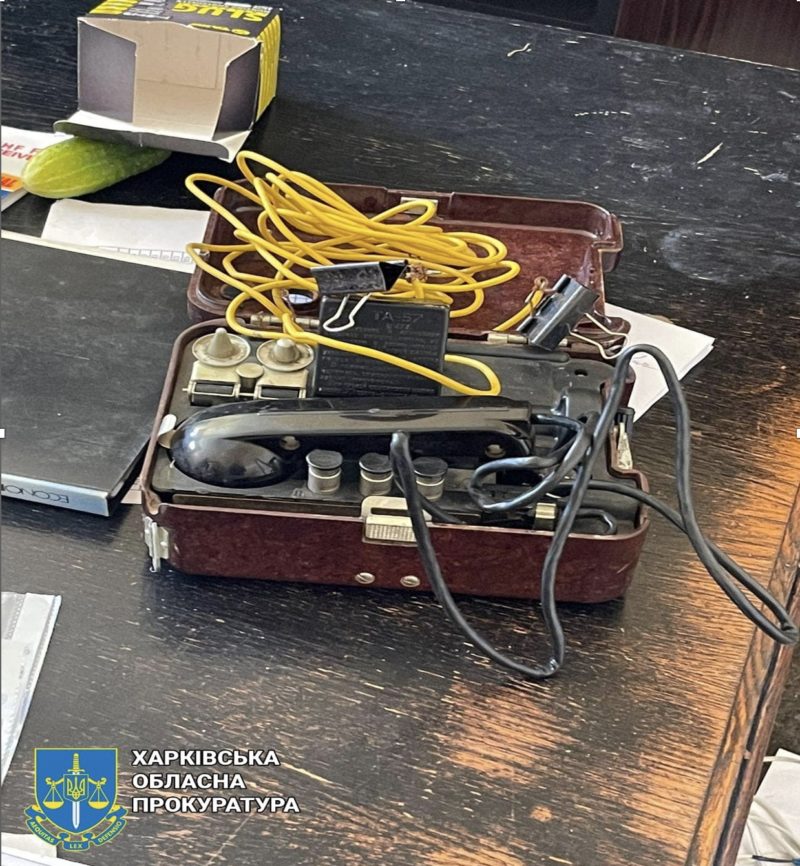
An improvised device for torture by electric current, which was used in Kozacha Lopan
A resident of Kupiansk told the Security Service of Ukraine that an FSB investigator interrogated him, call sign "Kot," who tried to torture prisoners into telling them which locals supported Ukraine, which ones were part of the territorial defense forces, and which ones were former military servants. During the first interrogation, the survivor was
"shocked with electric current for 40 minutes"
and shot with a pneumatic or gas gun. He was beaten with a bat and with pipes. According to him, other prisoners had swastikas burned onto their skin with a soldering iron.
Law enforcement agencies have started investigations, which will eventually show how many people were killed by the Russians in the torture chambers.
Looting in Kharkiv Oblast: a hallmark of Russian war crimes
The fact that the war is also being waged against the Ukrainian culture is yet again illustrated by Russians burning a church of the Orthodox Church of Ukraine before their escape, as reported by its press service. Ukrainian servicemen in Izium found weapons and museum items stolen by Russians during the city's occupation. The director of a mental hospital near Borova in Kharkiv Oblast also reported theft during the occupation.
Looting and robbery, particularly car theft, became an extra "bonus" for the invading army. During the Russians' retreat, about 300 cars were observed on the Starobilsk-Luhansk motorway, mostly from Kharkiv Oblast, on their way to Luhansk.
"Most vehicles had trailers loaded with stolen goods and were driven by Russian military servants,"
said the speaker of the General Staff of the Armed Forces of Ukraine.
In addition, the EuroKharkiv website reported a convoy of 150 Russian soldiers leaving from Borshchova and Artemivka on two buses, one lorry, and 19 stolen cars.
Russia's invasion: the culmination of a program of genocide
The liberated Kharkiv oblast has highlighted the infrastructure of terror set up by Russia in the occupied territories. Russian special services are looking for non-combatants — former Ukrainian soldiers, police officers, and their relatives — and resort to cruel torture, particularly by electric current. The killing of civilians, looting, and rape are similar to what occurred during the attempt to capture Kyiv, particularly in Bucha. The terror against school teachers proves that Russia, as an actual fascist state, destroys any culture that can challenge it politically.
It could be assumed that such "wild" behavior is caused by lousy morale, psychological situation, and lack of discipline among Russian soldiers. But this is only partly true. There are already enough reasons to claim that the blame lies with the Putin regime in general. This regime, for years, cultivated anti-Ukrainian sentiment among Russians through state propaganda. It sent its generals to Ukraine with a clear program of genocide: the destruction of Ukrainian statehood, identity, and culture and the physical elimination of their active representatives.
Read more:
- “Thin fingers raised like a final plea for help.” Exhuming the Izium massacre
- The smell of death from Izium does not go away
- Mass graves in liberated Izium: Photo report
- Two more bodies of men tortured by Russian military found in Kharkiv Oblast
- Another Russian torture chamber found in liberated Kharkiv Oblast
- New Russian torture chamber found in deoccupied Kharkiv Oblast
- Ten torture chambers found in liberated Kharkiv oblast, six of them in Izium – Police
- Russian occupiers set up torture chamber in recently occupied Balakliia, Kharkiv Oblast
- More than 600 bodies have already been exhumed in the de-occupied Kharkiv Oblast
- One more Russian torture chamber with ripped out dentures was found in liberated village
- Ukraine finds torture chamber, mass grave in liberated village
- Ukraine finds 2 Russian torture chambers in village liberated from Russian troops
- Man killed in Russian “torture chamber” in Balakliia, police confirm – PHOTOS

